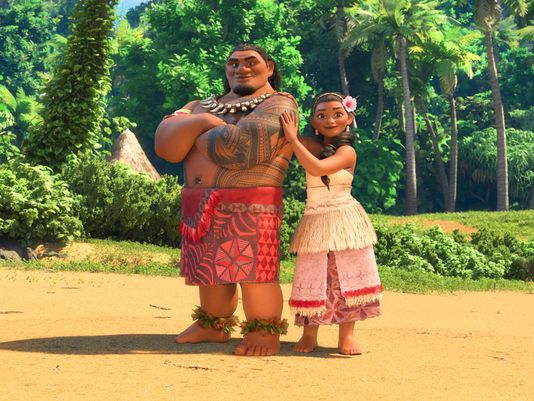Quick note to add the new Disney princess movie Moana to the animated gender series.
As in the case of Hercules, Disney can claim that the giant male Maui is a demigod so it’s normal that he’s many times larger than the princess, Moana. (There are a lot of large-bodied people in some Polynesian societies, but I don’t think this is a sex-specific pattern.) So instead look at Moana’s parents.

His big toe has the same diameter as her wrist. His unflexed bicep is wider than her waist. (Sources say the voice actor for Maui has 20-inch biceps, while a real life-sized Barbie doll would have an 18-inch waist, compared with 31 inches for a typical 19-year-old woman.) Anyway, it’s ridiculous.
But this is not unusual for animated kids-movie parents. Here are the parents from Brave and How to Train Your Dragon:


So, extreme dimorphism among parents is common in this genre. Why? I can’t say for sure, but here’s a clue — the parents from Frozen:

My, how similar their bodies are! Sure, her eyes are bigger than his mouth, and his hand is a little engorged, but that’s because there’s a baby in the scene. In the scale of things, they’re practically twins.
If the difference is in racial or ethnic context for the families, then maybe extreme dimorphism among parents helps signify the exoticism of the culture depicted. Of course Black men are often stereotyped as having superhuman bodies, but super petite women don’t usually go along with that particular trope, so I’m not sure how to interpret this. Ideas welcome.

Possibly explanation: the parents from Frozen are effete and civilized, while the fathers from the other movies come from times and places in which we romantically fantasize about manly warriors and hunters.
LikeLike
I already asked this question some time ago, but no one commented, so maybe this time someone will want to share their thought:
* I see that in Japan (a society which is arguably less egalitarian than US), there is less sexual dimorphism in anime than in western animated movies
* I see that in the past (in societies which without doubts were less egalitarian) there was less sexual dimorphism in art
So… what if art just strives to stress the stereotypical differences exactly because the real differences are becoming less visible?
LikeLike
The simplest explanation here is that Disney is trying to give their princess movies more”relatable” make characters as a way to pay the gender typecasting of those movies. As in, Disney had been so successful marketing these movies to young girls that young boys now don’t want to go see them.
Their solution is to take the positive make characters and hope up their masculinity and sexual dimorphism. Elsa’s dad isn’t dimorphic because he’s not a character who makes good decisions and who does early on. Kristoff on the other hand is much more dimorphic because he’s the “fun” male character.
LikeLike
I have ended up on this post because of the new “Maya and the Three” movie on Netflix. Holy moly, the sexual dimorphism is off the charts! Someone needs to rein this back in…
LikeLike